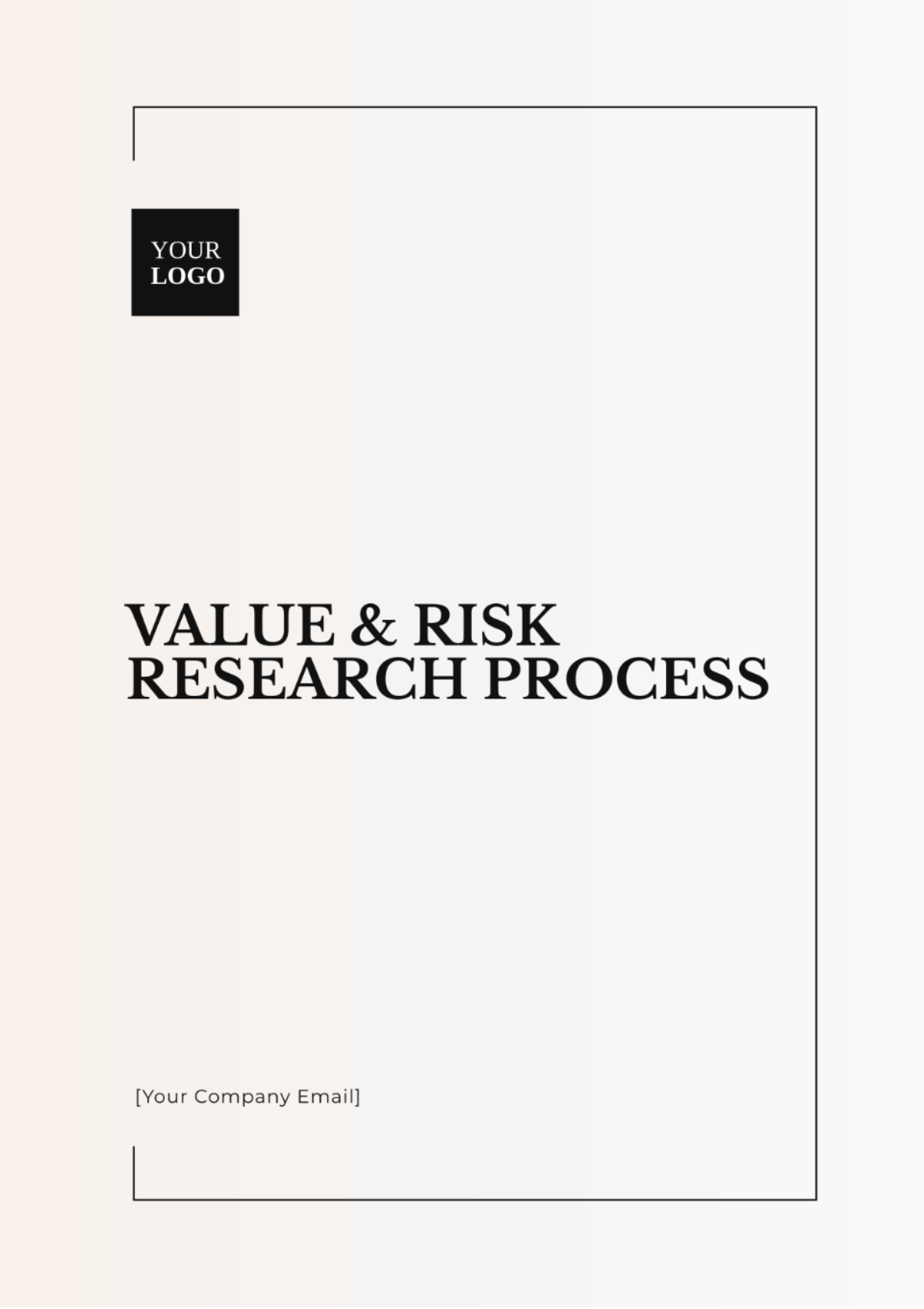Free Value & Risk Research Process

Prepared By: [YOUR NAME]
Date: [DATE]
I. Executive Summary
This research evaluates the value and risks associated with implementing a new customer relationship management (CRM) system. Key findings indicate substantial financial and strategic benefits, including increased revenue and improved customer engagement, though there are risks such as potential integration issues and data security concerns. Recommendations include implementing robust risk mitigation strategies and ongoing value monitoring to ensure alignment with strategic goals.
II. Objective and Scope
Objective: Assess the potential value and risks associated with the implementation of a new CRM system.
Scope: Includes financial (costs and returns), strategic (alignment with business goals), operational (integration and efficiency), and compliance (data protection and regulatory requirements) dimensions. The research aims to provide actionable insights to guide decision-making and implementation strategies.
III. Value Analysis
The value analysis focuses on both tangible and intangible benefits derived from the new CRM system:
Financial Value: Projected returns from increased sales, cost savings from streamlined processes, and revenue generation potential.
Strategic Value: Enhanced alignment with customer engagement goals, improved market competitiveness, and increased capacity for innovation.
Operational Value: Improvements in operational efficiency, productivity gains, and scalability of customer management processes.
Intangible Value: Enhanced brand reputation, higher customer satisfaction, and improved employee morale.
Benefit Analysis
Benefit | Quantitative Impact | Qualitative Impact |
|---|---|---|
Cost Savings | $500,000 annually | Enhanced operational efficiency |
Revenue Generation | $1,000,000 in the first year | Market expansion opportunities and increased customer retention |
Brand Reputation | N/A | Positive public perception and increased customer loyalty |
IV. Risk Assessment
Identified and analyzed potential risks associated with the CRM system implementation:
Financial Risks: Budget overruns due to unforeseen costs, revenue shortfalls if the system doesn’t meet expectations and funding uncertainties.
Operational Risks: Process disruptions during system integration, technical failures, and limitations in IT resources.
Compliance Risks: Changes in data protection regulations, legal challenges related to customer data, and adherence to compliance standards.
Strategic Risks: Misalignment with long-term business goals, threats from competitors with advanced CRM solutions, and market volatility affecting ROI.
Risk Analysis
Risk | Probability | Impact | Mitigation Strategy |
|---|---|---|---|
Budget Overrun | High | Severe | Implement strict budgeting controls and conduct regular financial reviews |
Process Disruption | Moderate | High | Develop and test comprehensive contingency plans and have a dedicated support team |
Regulatory Changes | Low | Moderate | Conduct regular compliance reviews and update systems as needed to meet new regulations |
V. Data Collection and Methodology
This research utilizes both primary and secondary data sources. Primary data includes surveys, interviews, and case studies, while secondary data encompasses industry reports, market analyses, and academic journals. Analytical techniques such as SWOT analysis, cost-benefit analysis, and risk assessment frameworks have been employed.
VI. Scenario Analysis
Evaluates different scenarios and their potential outcomes for the CRM implementation:
Best-Case Scenario: Efficient execution of the CRM system with favorable market conditions, leading to high financial returns, significant improvements in customer engagement, and enhanced competitive advantage.
Worst-case scenario: Major implementation challenges and adverse market conditions resulting in significant financial losses, low user adoption, and strategic setbacks.
Most Likely Scenario: Moderate challenges during implementation with achievable solutions, leading to balanced financial returns, steady improvements in customer engagement, and manageable risks.
Scenario Analysis
Scenario | Description | Potential Outcome |
|---|---|---|
Best-Case | Efficient execution and favorable market conditions | High financial returns, enhanced customer satisfaction, and improved market position |
Worst-Case | Implementation challenges and adverse market conditions | Significant financial losses, low system adoption, and reduced strategic benefits |
Most Likely | Moderate challenges with achievable solutions | Balanced financial returns, gradual improvements in customer engagement, and manageable risks |
VII. Recommendations
Implement comprehensive risk mitigation strategies focusing on high-impact risks such as budget overruns and process disruptions.
Establish a monitoring and evaluation framework to continuously assess value realization from the CRM system.
Improve communication with stakeholders to guarantee their alignment and backing for the CRM system rollout.
Ensure adequate resources are set aside for contingency planning and adaptive strategies to manage uncertainties.
VIII. Appendices
A: Financial Projections for CRM System Implementation
B: Risk Assessment Matrices detailing identified risks and mitigation strategies
C: Survey Results from CRM system users and industry experts
References
Smith, J. A., & Nguyen, L. K. (2051). Advanced CRM Systems and their Role in Shaping Customer Engagement. Global Business Insights Publishing.
Johnson, M. R. (2053). The Evolution of CRM: Financial and Strategic Benefits in the New Decade. Journal of Future Business Research, 12(4), 89-105.
Taylor, S., & Brooks, E. (2055). Mitigating Risks in CRM Implementations: Lessons from Recent Case Studies. International Conference on Business Technology Proceedings, 18(2), 134-150.
- 100% Customizable, free editor
- Access 1 Million+ Templates, photo’s & graphics
- Download or share as a template
- Click and replace photos, graphics, text, backgrounds
- Resize, crop, AI write & more
- Access advanced editor
Maximize project success with Template.net's Value & Risk Research Process Template. This editable and customizable template helps you assess and balance value and risk throughout your research process. From identifying potential pitfalls to outlining risk mitigation strategies, this template is your roadmap to informed decision-making. Editable in our Ai Editor Tool, it offers flexibility and adaptability





























